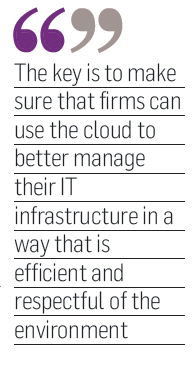Dermot O'Connell, Dell Ireland country manager
From smartphones to social networking, our working lives are set to be transformed forever and at the heart of this transformation is cloud computing.
For Dell Ireland country manager Dermot O’Connell, this transformation has been under way for quite some time now and Dell itself has felt these changes profoundly.
Dell expects to recruit 150 people in the next two years with the creation of its first Cloud Research and Development (R&D) Centre in Dublin and its first Dell Solution Centre built globally in Limerick. Recruitment is under way at both sites for world-class software engineers, IT architects, engineers and developers.
This transformation of the IT world is already filtering into the business world.
“Typically, if we look at the way we’ve worked over the last 15 to 20 years, we were given a computer and that computer was used to access internal software applications and maybe some web browsing.
“What we’re seeing now is employees of companies are also consumers and many have a better PC experience at home than they have at work.
“There is a huge change occurring in the industry, where CIOs and organisations are trying to figure out how they can give people a collaborative environment to work in.
“Also there are the expectations of Generation Y who won’t work without access to Google, Facebook or Twitter. So there are huge shifts occurring, driven by some of the major cloud initiatives in the social networking space, for example.”
I ask O’Connell how firms are aligning their IT resources to meet these challenges head on.
“There are two types of cloud experience,” he replies. “There’s the private cloud where businesses use cloud technology within their infrastructure to enable faster applications, disaster recovery and be generally more efficient.
“Then there’s the public cloud, which refers to applications you’ll see on the internet, such as Salesforce.com, and that also has advantages for firms who don’t want to manage large amounts of infrastructure.”

But while most of us in our private and working lives have embraced elements of cloud computing, O’Connell agrees that organisations’ uptake of cloud is not occurring as fast as vendors would like. At the heart of the issue is concerns around security.
“If you filled Croke Park with people there would be more of a security risk than if there was just one person there. The reality is that with any new technology that involves pooling IT resources, there are going to be security concerns. But I’m confident the technologies to block attacks are getting better and better,” he says.
Dell has been working to ally organisations’ concerns by beefing up security around its servers, including the acquisition of SecureWorks, which is capable of blocking attacks by hackers on corporate servers.
In fact, Dell has acquired more than 10 companies in the last 18 months in areas of storage, security and systems management.
“The key is to make sure that firms can use the cloud to better manage their IT infrastructure in a way that is efficient and respectful of the environment.
“Imagine an executive is sitting in an airport and there is an issue with a notebook PC. A cloud-based service will be able to discover the fault, diagnose it and fix it remotely over the internet. That’s a hugely powerful proposition.”
O’Connell says Ireland is at the heart of Dell’s solutions for the cloud. “There will be key technologies such as storage-as-a-service, for example, that will be coming to market specifically tailored for the business world.
“In Ireland, we’ve recently announced the Cloud R&D Centre and the Cloud Solutions Centre and we’re hiring developers and engineers to build clever products for the industrywide OpenStack.
“This is great from an Ireland perspective and will change the conversation from being just about ‘cloud technology’ to simply coming up with solutions that just help businesses do things better.”